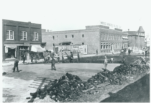Praxis: The answer is blowing in the wind
By Medicine Hat News on October 21, 2017.
Wow, what a windy week! It is hard to believe the wind was strong enough to topple large, towering evergreens, poplars and even willows. There were branches, leaves, signs, parts of roofs and various other pieces of debris scattered around the city this week. Crews have been out diligently working, but it is going to take some time to get everything cleaned up; that is for sure. Well, you know me, what better opportunity than recent events to relate to science. I actually had a young scientist ask me “how do they measure wind speed?” The tool that is used is an anemometer. Not only is this word difficult to pronounce, but it is also a bit expensive to purchase just for the average person. This prompted me to come up with a simple home version you can try out. Let’s get started! *Remember to ask an adult before doing this experiment. Materials – 5 small paper cups (“Dixie cups”) – 2 drinking straws – tack – good heavy masking tape – pencil (with a new eraser) – handheld hole punch – permanent marker – scissors – ruler – stopwatch hairdryer or fan (optional) – windy day Procedure Take one of the cups and using the ruler measure 1.5 cm below the rim. Put a mark here. Repeat with three more cups. Using the hole punch, punch a hole at each mark. Set aside. With the final cup, measure 1.5 cm below the rim and mark it. On the opposite side of the cup, repeat. Still using the final cup, measure 1 cm below the rim and mark the spot. Repeat on the opposite side of the cup. You should have four marks on this cup. Using the hole punch, punch holes in each of the four marked spots. Carefully push the pencil through the bottom of the cup. Set aside. Take one of the cups with just one hole in it. Carefully slide the straw through the hole in the cup. Bend about 1cm of the end of the straw in the cup and tape it well. Repeat for the other three cups. Place the other end of the straw through two of the holes in the fifth cup and then through the hole in one of the other cups. Tape the end of the straw to the inside of the cup as you did earlier, making sure that the openings of the two cups face opposite directions. Repeat, sliding the straw through the remaining two holes in the cup. Make sure that the opening of each cup faces the bottom of the cup next to it (in other words, no two openings should be facing each other). Each of the four cups should be facing sideways. Insert the pencil with the eraser facing up through the bottom of the fifth cup. Carefully push the tack through the two straws and into the eraser on the pencil. Mark an ‘X’ with your marker on the bottom of one of the cups. You are ready to measure wind speed! Find a windy location. Watch the bottom of the cup as it spins around (the number of revolutions). You need to be able to see the ‘X.’ Using the stopwatch, time 10-second intervals. Count the number of times the ‘X’ goes by in 10 seconds. In order to calculate the wind speed, use the chart below: 2-4 revolutions ~ 2km/hr 5-7 revolutions ~ 3 km/hr 10-12 revolutions ~ 6km/hr 19-21 revolutions ~ 11 km/hr 30-32 revolutions ~18 km/hr 41-43 revolutions ~ 24 km/hr 50-51 revolutions ~ 29 km/hr Explanation In this experiment you made a very simple wind speed anemometer. An anemometer is a device used for measuring wind speed, and is common weather station instrument. The number of revolutions in a given time period will allow you to calculate the approximate wind speed. Now if by chance, it is not windy out (which I highly doubt this week), use a hair dryer or fan to test out your anemometer. Patty Rooks is senior scientific consultant at PRAXIS, “Connecting Science To The Community.” Contact Praxis at praxis@praxismh.ca, http://www.praxismh.ca, Tweet or follow us @PraxisMedHat, or friend us on Facebook. 47-46




